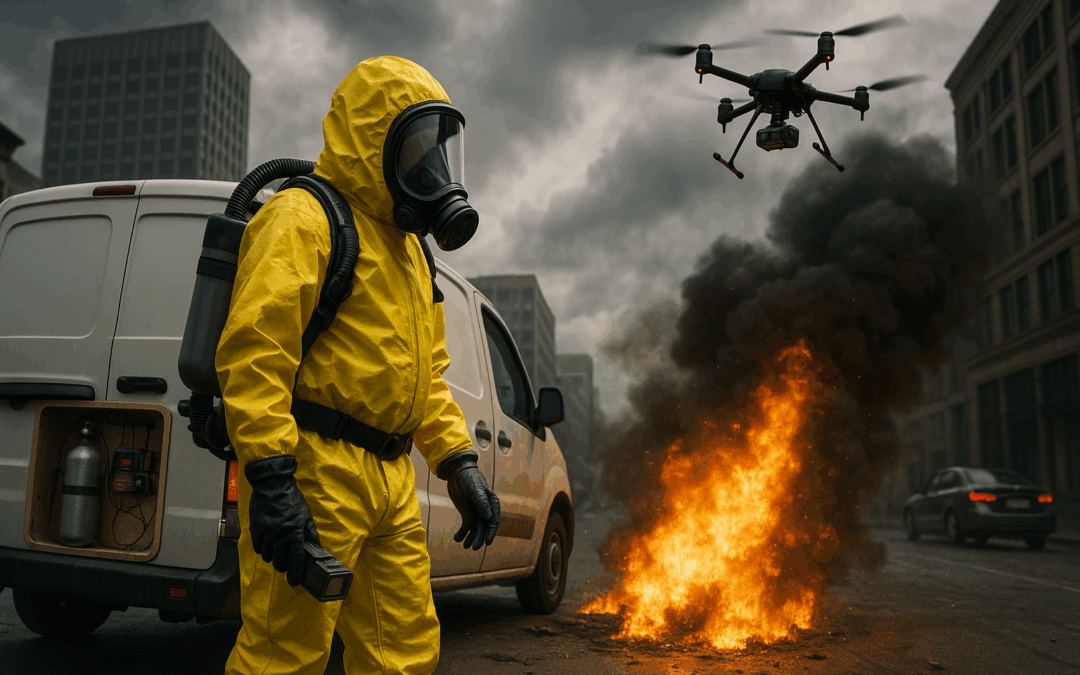From Secondary Devices to Drone Ambushes: Hazmat in the Age of Evolving Terror
The Episode We Didn’t Expect – But Definitely Needed
When I sat down with Bobby Salvesen and Mike Monaco for episode 420 of The Haz Mat Guys, we joked about the number. Should’ve been a cannabis episode, right? Instead, we ended up in one of the most vital conversations we’ve ever had – about how hazmat response has changed in a world where threats keep evolving.
This wasn’t a theoretical talk. It was raw, honest, and grounded in decades of boots-on-the-ground experience. From the aftermath of 9/11 to today’s drone-enabled attacks, Bobby and Mike didn’t hold back.
“We Thought We’d See More of This…” But Then It Changed
Right out of the gate, Mike admitted something that hit hard: “We thought we’d be going to lots of stuff like this… but it changed.”
He’s right. After 9/11, the training world ramped up for the next big attack. But as the years went by, the calls weren’t what we expected. The attacks did come – but they were more subtle, more fragmented, and, in many cases, more dangerous because of that.
Terrorism didn’t go away. It adapted.
The Return of the Secondary Device: Old Lessons We Forgot
One of the first things we revisited was the idea of secondary devices – a concept burned into early-2000s training but slowly forgotten over time. Back then, you’d get on the rig and see a label: SECONDARY DEVICES in huge letters. A daily reminder not to get comfortable.
We went through real-world examples that still haunt the responder community:
- The 1997 Atlanta bombing, where a second device targeted arriving responders.
- A Puerto Rican peace officer killed by a flashlight bomb.
- The Boston Marathon, where a planned secondary blast almost made things worse.
These weren’t isolated incidents. They were warning signs.
“Normalization of deviance has crept in,” Mike told me. “We get off for the mundane stuff totally half-dressed… and that’s a problem.”
He’s not exaggerating. The moment we start thinking “this is just another call,” we open ourselves up to disaster.
The Gear’s Better – But That’s Not the Whole Story
One bright spot? We finally have the tools we dreamed of in 2001:
- Active shooter kits
- Level A suits with integrated detection tech
- Mesh-networked sensors and robotic reconnaissance
- Drones used for scene surveillance and detection
But the same drones that help us can be used against us.
“If I was a bad guy,” Mike said, “why leave it to chance that a rig parks in the same spot? I’d fly a drone in and pick my target.”
The drone threat is real – and we’re already behind. In Ukraine, they’re dropping bombs into tank hatches with shocking precision. In a chaotic fireground, who’s watching the sky?
Patterns Kill: Why Predictability Is a Threat
We talked a lot about how habits – while time-saving – can also be lethal. Always staging in the same spot? Taking the same route to every call? That’s exactly what an attacker counts on.
I shared a story from a hazmat old-timer: he’d take a different bridge into Manhattan every time. Why? “If they don’t know what road I’ll be on, they can’t plant something there.”
It might sound extreme – until it saves your life.
Communication Failures: The Story That Stuck With Me
One of the most powerful moments in the episode was when Mike shared a story about a suspicious car parked near a Jewish school – filled with wires and gas cans. He tried to raise the alarm. No one listened.
“I thought I communicated well… but it didn’t matter,” he said.
And that’s the crux: communication in crisis isn’t just about saying something. It’s about being heard, being clear, and being insistent enough to cut through the chaos.
Drillers Make Killers: Why Muscle Memory Matters
There’s a saying in jiu-jitsu: “Drillers make killers.” Mike dropped that line, and it landed hard.
We don’t rise to the occasion. We fall to the level of our training.
Every hazmat team should be drilling to spot secondary devices like they practice donning SCBA or pulling a line. If you need to stop and think, it’s already too late.
Dynamic Threats: The New Reality of Hazmat
Gone are the days of static devices in dumpsters. Today’s attackers use:
- Remote triggers
- Pressure switches
- Multi-point attacks
- Weaponized drones
- Explosives designed to spread chemicals or radiation
And they don’t just hit once. These attacks are layered – designed to confuse, divide, and overwhelm.
A Hard Lesson in Ego and Role Clarity
Bobby shared a story that changed the way he sees his job. He was getting ready for a call, fully suited up, when a cop with a long gun stood beside him.
“Your job is to fix that. Mine is to keep you safe,” the officer said.
That hit him. For years, Bobby thought he was the star of the show. But in that moment, he realized: hazmat is one part of a much bigger puzzle. Knowing your place in that system can save lives – not just your own.
Urban Planning Meets Emergency Response
What struck me was how both Mike and Bobby drew lessons from urban planning – yes, city design – to inform field response.
Those big planters and benches downtown? They’re vehicle barriers in disguise.
First responders can adopt the same ideas on the fly:
- Use rigs to block incoming threats.
- Place command posts away from suspicious vehicles.
- Assign someone to watch the perimeter – like a spotter at a construction site.
The Public Is Still Your Best Sensor
“If you see something, say something” became a punchline over time – but it works. The public won’t disarm a device, but they can spot something that feels off.
Teaching civilians what to look for – unattended bags, loitering near scenes, unusual drone activity – turns them into a force multiplier.
What’s Coming Next from The Haz Mat Guys
This episode wasn’t just a one-off. Mike and Bobby are launching two new series:
🔋 The Battery Destroyers Club (Dec 13, 2023):
A video watch party + expert breakdown of real-world battery incidents. Expect input from heavy-hitters like FLIR and Teledyne.
🎤 After Action Report Podcast (Jan 3, 2024):
Stories from hazmat’s founding legends, starting with Mike Callen. No time limits, no filters, all insight.
Final Thoughts: Stay Humble, Stay Adaptable
This conversation changed the way I look at hazmat. The threats are smarter. The gear is better. But the real difference? Mindset.
So here’s what I’m taking away – and I hope you do too:
- Break your patterns.
- Drill like your life depends on it – because it does.
- Speak up, and make sure your voice cuts through.
- Learn from everyone – police, city planners, even civilians.
- And never forget: your goal isn’t to be the hero. It’s to get everyone home.
As Mike said at the end:
“We want to make effective decisions that allow us – the responders – to go home at night.”
That’s always been the mission.
Call to Action
Let’s keep this conversation going. If you’re a firefighter, medic, hazmat tech, or anyone in emergency response, ask yourself:
✅ Are your drills built around today’s threats – or yesterday’s?
✅ Have you walked your team through a real secondary device scenario?
✅ Do your protocols account for drone attacks or ambush-style setups?
Drop your thoughts or stories in the comments. Forward this to your shift. And hit subscribe on The Haz Mat Guys – because Part 2 is coming, and you’re not going to want to miss it.


